Secure RF/FSO Communications Towards the 6G Era
Olfa Ben Yahia and Gunes Karabulut Kurt, Polytechnique Montreal, Canada; Eylem Erdogan, Istanbul Medeniyet University, Turkey; Ibrahim Altunbas, Istanbul Technical University, Turkey; and Halim Yanikomeroglu, Carleton University, Canada
(This email address is being protected from spambots. You need JavaScript enabled to view it., This email address is being protected from spambots. You need JavaScript enabled to view it., This email address is being protected from spambots. You need JavaScript enabled to view it., This email address is being protected from spambots. You need JavaScript enabled to view it., This email address is being protected from spambots. You need JavaScript enabled to view it.)
Abstract
Compared to terrestrial infrastructures, wireless heterogeneous networks provide cost-effective global coverage with high-speed data connectivity. Furthermore, to overcome the spectrum limitations imposed by radio frequency communication and to meet the demands of high data rates, free-space optical links present an alternative solution. This work sheds the light on the physical characteristics of radio frequency and free-space optical links from a communication and physical layer security perspectives. Motivated by the complementary behavior of both communication channels, we first investigate hybrid radio frequency/free-space optical communications. Then, we provide an overview of the physical layer security of both channels considering different scenarios and conditions.
1. Introduction
The seamless integration of space and terrestrial networks is one of the promising architectural aspects of the sixth generation (6G) networks. Known as a vertical heterogeneous network (VHetNet), this architecture comprises space, aerial, and terrestrial networks. The envisioned space network consists of different types of satellite constellations, including geostationary Earth orbit, medium Earth orbit, and low Earth orbit (LEO), which are connected via high data rates inter-satellite links. LEO satellites are expected to have a pivotal role in future wireless communication by providing high data rate, low latency, and wide coverage that includes remote rural areas. For this reason, thousands of LEO satellites are planned to be launched for deployment by different commercial and public companies in the next decade, where these companies want to design a flexible network with seamless global coverage and high capacity.
The aerial network layer, which includes flying platforms, is divided into two interacting sub-layers [1]. The first sublayer is composed of unmanned aerial vehicle (UAV) nodes, which are known as drones. UAVs are low-altitude flying vehicles operating near the ground up to 150 m. UAVs provide inherent characteristics such as flexibility, mobility, easy deployment, and low costs. In recent years, UAVs have become enablers for different wireless applications that include surveillance, monitoring, military operations, and delivery due to their capabilities to hover at adaptive altitudes [2]. The second sub-layer includes high altitude platform station (HAPS) systems, also known as stratospheric repeaters [3]. HAPS is defined as a quasi-stationary object flying at an altitude of 20 to 50 km, whereas, most of the recent deployments focused on an altitude between 18 km and 20 km [4]. HAPS systems can offer complementary characteristics over satellite communication (SatCom) and terrestrial infrastructure. These stratospheric platforms provide narrowband, broadband, and broadcasting telecommunication services [3]. Positioned above the clouds, HAPS systems can serve large areas due to their large footprint with lower costs compared to LEO satellites.
Up to date, the majority of existing VHetNet links are operating based on microwave radio frequency (RF) bands. However, RF communication requires regulatory restrictions, high costs, provides limited capacity, and cannot meet the high demands in data rate communication. Moreover, RF communication is prone to an interception, jamming, and security risks. Thus, owing to the good directivity and the fast deployment, free-space optical (FSO) communication is the key enabler to meeting these high data rate requirements and solving the above problems. However, it is worth mentioning that FSO communication is sensitive to weather conditions, atmospheric effects, beam wanders, and pointing errors. Furthermore, due to diffraction, an amount of the beam can be reflected by small particles present in the atmosphere and then received by illegitimate users [5]. Moreover, when there is no perfect line-of-sight between transmitter and receiver caused by pointing error issues, an eavesdropper can capture the information.
Overall, the vision of 6G is produced by several innovations and developments in architecture, applications, and technologies. Meanwhile, attackers become more powerful and sophisticated, capable of developing new types of security risks [6]. In this context, to study the secrecy performance of future networks from a physical layer perspective, we first need to understand the communication performance. Herein, our work provides a comprehensive study of the physical layer of non-terrestrial networks (NTN) from two aspects; communication and security.
Figure 1: Illustration of weather-dependent hybrid RF/FSO SatCom.
2. Hybrid RF/FSO communication
Due to the complementary nature of RF and FSO channels, we propose two different system models in which we implement RF and FSO links in parallel [7], [8]. As widely known, the performance of FSO communication is highly degraded by fog and snow, whereas RF communication is highly affected by rain [9]. Thus, we propose two novel reliable strategies for downlink SatCom using hybrid RF/FSO communication.
In the first model which is shown in Figure 1, we consider an LEO satellite communicating with a ground station (GS) through RF and FSO communication [7]. In the proposed strategy, the LEO satellite can switch between RF and FSO links depending on the weather status obtained from the sensors on the satellite and used for context awareness. Moreover, we allocate equal transmit power on both channels. In this approach, we assume three different states of weather. In State-0, we assume the presence of a thin cloud. Thus, both RF and FSO channels show high performance, and both might be active simultaneously and combined at the GS using the selection combining (SC) scheme. For State-1, we assume rainy weather, thus the RF channel is highly affected and the transmission is handled through FSO communication using the total transmit power Pt. Likewise, for State-2, we assume foggy weather where FSO communication is not available and the RF channel is used with total transmit power Pt. The simulation results have shown that our proposed strategy outperforms the dualmode hybrid RF/FSO communication in which the total transmit power is always divided into Pt/2 for all states in terms of outage probability. Thus, our proposed scheme improves power efficiency. Moreover, we study the impact of non-zero boresight pointing error and the impact of the aperture averaging technique for the proposed setup. The results have revealed that increasing the boresight displacement deteriorates the overall performance. Furthermore, increasing the aperture size can alleviate the effects of misalignment and atmospheric turbulence and thus improve performance.
In the second scenario, the communication between an LEO satellite and a GS may be unavailable due to barriers, shadowing effects, or huge attenuation between them. Thus we propose to use a dual-hop multi-relay scheme to guarantee reliable communication as illustrated in Figure 2. Recently, the authors in [10], [11] introduced the use of HAPS in hybrid RF/FSO SatCom communication. It has been observed that the use of HAPS enhances the reliability of SatCom systems. Therefore, different from the current literature, we propose a novel HAPS selection strategy for hybrid RF/FSO communication [8]. Specifically, a HAPS system that can provide the best channel characteristics is selected in the first hop and acts as a decode-and-forward relay. In the second hop, the selected HAPS decodes and forwards the signal to the GS through hybrid RF/FSO communication. At the GS, SC is deployed with equal transmit power on both channels. In this work, we consider the effects of stratospheric attenuation, atmospheric turbulence, atmospheric attenuation due to scattering, path loss, fading, and temperature. Furthermore, we studied the impact of zero-boresight pointing errors, and aperture averaging techniques. From the simulation results, we concluded that the proposed scheme outperforms the single-hop RF and FSO communications, single-hop hybrid RF/FSO, the HAPS-aided FSO, and HAPS-aided RF communications. Thus, the use of HAPS as a relay node improves SatCom’s performance as the FSO link from the satellite to the HAPS is barely affected by atmospheric conditions. Also, the HAPS selection scheme based on the satellite-HAPS channel quality enhances the overall performance. 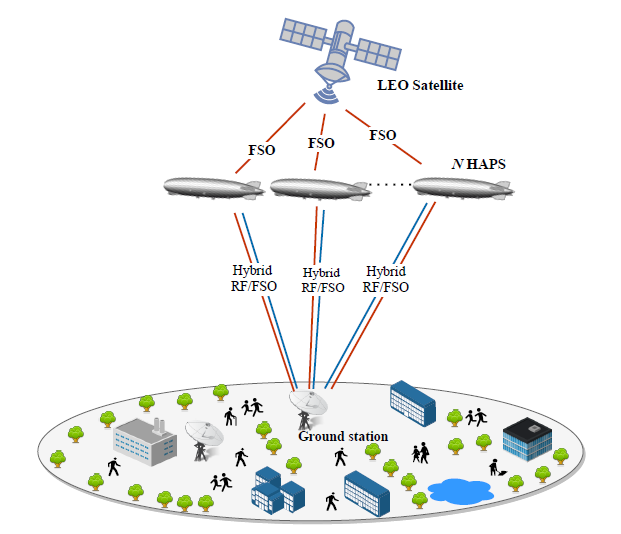
Figure 2: Illustration of the HAPS node selection for hybrid RF/FSO SatCom.
Furthermore, for rainy weather, the RF link is highly affected, yet, it remains available. The FSO communication is slightly affected by rain, whereas, it is highly deteriorated by fog. The misalignment between the satellite and the HAPS node introduced by pointing errors degrades the overall performance. To reduce the impact of turbulence-induced fading and pointing errors, the aperture averaging technique can be used. In addition, the results have shown that decreasing the zenith angle or the wind speed decreases the atmospheric attenuation and enhances the overall performance.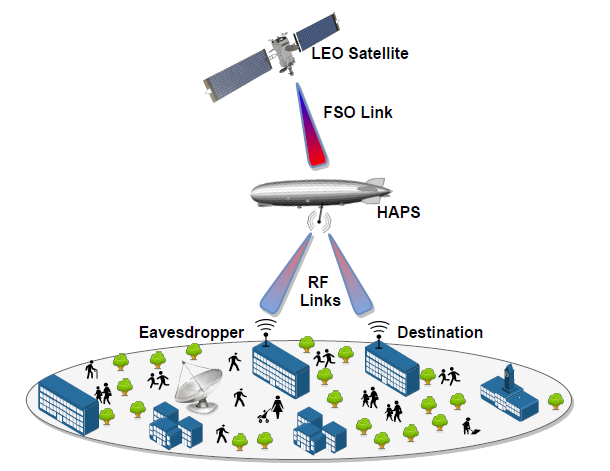
Figure 3: Illustration of the HAPS-aided FSO-RF SatCom system model.
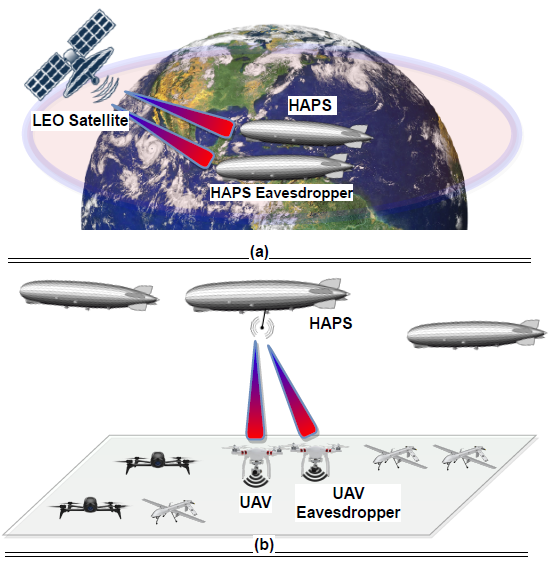
Figure 4: (a) HAPS eavesdropping, (b) UAV eavesdropping.
3. Physical Layer Security Performance
To investigate the RF eavesdropping in downlink SatCom, we proposed a new dual-hop HAPS-aided downlink communication [12]. As shown in Figure 3, we assumed an LEO satellite communicating with a GS through a HAPS node in the presence of a malicious user located on the ground and trying to intercept the communication. FSO communication is adopted between the satellite and the HAPS node, whereas RF communication is considered between the HAPS and the ground receivers. We derived closed-form of secrecy outage probability (SOP) and probability of positive secrecy capacity (PPSC) expressions by considering the impact of pointing errors and different shadowing levels. The simulation results have shown that the proposed HAPS-aided FSO-RF SatCom model is more secure than direct satellite-ground RF communication. Due to its strategic position, the HAPS node is able to provide secure communication even in harsh winds in the first hop of communication. Furthermore, the zenith angle is considered an important enabler in the design of FSO communication to decrease the effects of atmospheric conditions. For the design of the RF communication, severe shadowing effects deteriorate the overall secrecy performance. Furthermore, as the pointing errors increases, the system performance worsens. Finally, the average signal-to-noise ratio (SNR) of the eavesdropper can be a crucial parameter to guarantee secure communication.
In what follows, we investigate optical eavesdropping in NTNs [13], [14]. We proposed novel use cases for attacks in space as can be seen in Figure 4. In the first use case, we assumed an LEO satellite that is communicating with a HAPS node while an external HAPS is trying to collect the transmitted information. In the second use case, we considered a HAPS node sending secret information to a UAV in the presence of a UAV eavesdropper. The communication in both scenarios is through FSO links. Furthermore, we assumed that the illegitimate receivers are located very close to the main receivers. Final expressions of SOP and PPSC were derived and validated with MC simulations. In this work, we studied the effects of zenith angle, wind speed, aperture averaging technique, and atmospheric/stratospheric attenuation. The simulation results have shown that the HAPS eavesdropping scenario is more secure than the UAV eavesdropping. Furthermore, the higher the wind speed level, the more the leakage of the information to the eavesdropper. This shows the huge impact of atmospheric effects on the secrecy performance.
In the scenario depicted in Figure 5, we proposed a satellite eavesdropping strategy, in which the optical communications established between an LEO satellite and a HAPS node can be captured by an attacker spacecraft, which is located within the convergence area of the transmitted optical beam [14]. Considering two practical eavesdropping scenarios, satellite-to-HAPS (downlink) and HAPS-to-satellite (uplink), we derived novel expressions of average secrecy capacity, SOP, and secrecy throughput. The main findings of this work can be summarized as follows. In terms of SOP, the satellite-to-HAPS communication shows better performance as the eavesdropper gathers more information in the uplink due to reflection or refraction based on the large distance. Additionally, the secrecy performance is directly affected by the fluctuations in the signal due to atmospheric conditions. Finally, it has been observed that after a certain level of secrecy rate, the system’s reliability and secrecy are compromised.
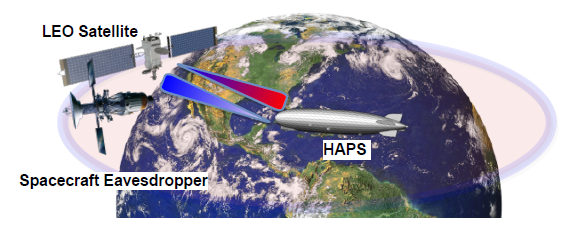
Figure 5: Illustration of the satellite eavesdropping.
According to [15], the threats given in this work can be categorized as loss of confidentiality, as the attacker eavesdrops or accesses sensitive information. To summarize, both the ground and space segments are susceptible to diverse types of attacks including electronic and physical ones. In addition, the development of new technologies for the 6G including artificial intelligence techniques and smart surfaces may introduce new threats such as poisoning and evasion attacks [6].
4. Conclusion
To conclude, the channel modeling and the radio propagation environment must be carefully designed to meet the envisioned requirements of future wireless networks in terms of quality of service and security. In this work, we summarized our studies concerning the physical layer performance of NTNs from a communication perspective, as well as evaluating the secrecy performance while assuming random channel characteristics without having any knowledge of the attacker’s ability.
In future work, we intend to propose new mitigation techniques for predicting, detecting, and preventing potential threats in the next generations of wireless networks. Finally, to enhance privacy and provide redundant security, a cross-layer framework can be considered in a use-case specific manner for the target service reliability level.
References
[1] M. S. Alam, G. Karabulut Kurt, H. Yanikomeroglu, P. Zhu, and N. D. D`ao, “High altitude platform station based super macro base station constellations,” IEEE Communications Magazine, vol. 59, no. 1, pp. 103–109, 2021.
[2] M. Mozaffari, W. Saad, M. Bennis, Y.-H. Nam, and M. Debbah, “A tutorial on UAVs for wireless networks: Applications, challenges, and open problems,” IEEE Communications Surveys Tutorials, vol. 21, no. 3, pp. 2334–2360, 2019.
[3] A. Aragon-Zavala, J. L. Cuevas-Ru´ız, and J. A. Delgado-Pen´ın, High-Altitude Platforms for Wireless Communications. John Wiley & Sons, 2008.
[4] G. Karabulut Kurt, M. G. Khoshkholgh, S. Alfattani, A. Ibrahim, T. S. J. Darwish, M. S. Alam, H. Yanikomeroglu, and A. Yongacoglu, “A vision and framework for the high altitude platform station (HAPS) networks of the future,” IEEE Communications Surveys Tutorials, vol. 23, no. 2, pp. 729–779, 2021.
[5] F. J. Lopez-Martinez, G. Gomez, and J. M. Garrido-Balsells, “Physical-layer security in free-space optical communications,” IEEE Photonics Journal, vol. 7, no. 2, pp. 1–14, 2015.
[6] P. Porambage, G. G¨ur, D. P. M. Osorio, M. Liyanage, A. Gurtov, and M. Ylianttila, “The roadmap to 6G security and privacy,” IEEE Open Journal of the Communications Society, vol. 2, pp. 1094–1122, 2021.
[7] O. Ben Yahia, E. Erdogan, G. Karabulut Kurt, I. Altunbas, and H. Yanikomeroglu, “A weather-dependent hybrid RF/FSO satellite communication for improved power efficiency,” IEEE Wireless Communications Letters, vol. 11, no. 3, pp. 573–577, 2022.
[8] “HAPS selection for hybrid RF/FSO satellite networks,” IEEE Transactions on Aerospace and Electronic Systems, (early access), pp. 1–13, 2022.
[9] F. Nadeem, V. Kvicera, M. S. Awan, E. Leitgeb, S. S. Muhammad, and G. Kandus, “Weather effects on hybrid FSO/RF communication link,” IEEE Journal on Selected Areas in Communications, vol. 27, no. 9, pp. 1687–1697, 2009.
[10] R. Swaminathan, S. Sharma, N. Vishwakarma, and A. Madhukumar, “HAPS-based relaying for integrated space-air-ground networks with hybrid FSO/RF communication: A performance analysis,” IEEE Trans. Aerosp. Electron. Syst., vol. 17, pp. 1–17, 2021.
[11] S. Shah, M. Siddharth, N. Vishwakarma, R. Swaminathan, and A. S. Madhukumar, “Adaptive-combining-based hybrid FSO/RF satellite communication with and without HAPS,” IEEE Access, vol. 9, pp. 81 492–81 511, 2021.
[12] O. Ben Yahia, E. Erdogan, and G. Karabulut Kurt, “On the use of HAPS to increase secrecy performance in satellite networks,” in IEEE International Conference on Communications Workshops (ICC Workshops), 2021, pp. 1–6.
[13] O. Ben Yahia, E. Erdogan, G. Karabulut Kurt, I. Altunbas, and H. Yanikomeroglu, “Physical layer security framework for optical non-terrestrial networks,” in International Conference on Telecommunications (ICT), 2021, pp. 162–166.
[14] “Optical satellite eavesdropping,” IEEE Transactions on Vehicular Technology, (early access), pp. 1–6, 2022.
[15] A. Dutta and E. Hammad, “5G security challenges and opportunities: A system approach,” in IEEE 5G World Forum (5GWF), 2020, pp. 109–114.6
 Olfa Ben Yahia received the Engineering degree with honors in Telecommunications from the Ecole Nationale d’Electronique et des T´el´ecommunications de Sfax, Sfax, Tunisia, in 2016 and the Ph.D. degree in Telecommunications Engineering from Istanbul Technical University, Istanbul, Turkey in 2022. She is currently a Postdoctoral Fellow with the Department of Electrical Engineering, Polytechnique Montr´eal, Montreal, QC, Canada. Her current research interests include optical wireless communications, performance analysis of physical layer security, satellite communication, aerial platforms, and cooperative communications. She is a Graduate Student Member of IEEE.
Olfa Ben Yahia received the Engineering degree with honors in Telecommunications from the Ecole Nationale d’Electronique et des T´el´ecommunications de Sfax, Sfax, Tunisia, in 2016 and the Ph.D. degree in Telecommunications Engineering from Istanbul Technical University, Istanbul, Turkey in 2022. She is currently a Postdoctoral Fellow with the Department of Electrical Engineering, Polytechnique Montr´eal, Montreal, QC, Canada. Her current research interests include optical wireless communications, performance analysis of physical layer security, satellite communication, aerial platforms, and cooperative communications. She is a Graduate Student Member of IEEE.
 Eylem Erdogan received B.Sc. and M.Sc. degree from Is¸ık University, Istanbul, Turkey and the Ph.D. degree from Kadir Has University, Istanbul, Turkey in 2014 all in electronics engineering. He is currently an Associate Professor in the Department of Electrical and Electronics Engineering, Istanbul Medeniyet University. He was a Post-Doctoral Fellow in Electrical Engineering department, Lakehead University, Thunder Bay, ON, Canada from March 2015 to September 2016 and a visiting professor in Carleton University, Ottawa, Canada during summer 2019. He has authored or coauthored more than 30 papers in peer-reviewed SCI/SCI-E journals and international conferences. His research interests include the broad areas of wireless communications, including cognitive radio net- works, physical layer security of wireless systems, nonterrestrial networks, free-space optical communications, and satellite communications. He is a Senior Member of IEEE.
Eylem Erdogan received B.Sc. and M.Sc. degree from Is¸ık University, Istanbul, Turkey and the Ph.D. degree from Kadir Has University, Istanbul, Turkey in 2014 all in electronics engineering. He is currently an Associate Professor in the Department of Electrical and Electronics Engineering, Istanbul Medeniyet University. He was a Post-Doctoral Fellow in Electrical Engineering department, Lakehead University, Thunder Bay, ON, Canada from March 2015 to September 2016 and a visiting professor in Carleton University, Ottawa, Canada during summer 2019. He has authored or coauthored more than 30 papers in peer-reviewed SCI/SCI-E journals and international conferences. His research interests include the broad areas of wireless communications, including cognitive radio net- works, physical layer security of wireless systems, nonterrestrial networks, free-space optical communications, and satellite communications. He is a Senior Member of IEEE.
 Gunes Karabulut Kurt received the B.S. degree with high honors in electronics and electrical engineering from the Bogazici University, Istanbul, Turkey, in 2000 and the M.A.Sc. and the Ph.D. degrees in electrical engineering from the University of Ottawa, ON, Canada, in 2002 and 2006, respectively. Between 2010 and 2021, she was with Istanbul Technical University. She is currently an Associate Professor of Electrical Engineering at Polytechnique Montr´eal, Montreal, QC, Canada. She is also currently serving as an Associate Technical Editor (ATE) of the IEEE Communications Magazine and a member of the IEEE WCNC Steering Board. Her current research interests include space information networks, satellite networking, wireless network coding, wireless security, space security, and wireless testbeds radio. She is the chair of the IEEE special interest group entitled “Satellite Mega-constellations: Communications and Networking.”
Gunes Karabulut Kurt received the B.S. degree with high honors in electronics and electrical engineering from the Bogazici University, Istanbul, Turkey, in 2000 and the M.A.Sc. and the Ph.D. degrees in electrical engineering from the University of Ottawa, ON, Canada, in 2002 and 2006, respectively. Between 2010 and 2021, she was with Istanbul Technical University. She is currently an Associate Professor of Electrical Engineering at Polytechnique Montr´eal, Montreal, QC, Canada. She is also currently serving as an Associate Technical Editor (ATE) of the IEEE Communications Magazine and a member of the IEEE WCNC Steering Board. Her current research interests include space information networks, satellite networking, wireless network coding, wireless security, space security, and wireless testbeds radio. She is the chair of the IEEE special interest group entitled “Satellite Mega-constellations: Communications and Networking.”
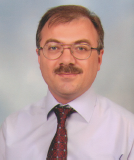 Ibrahim Altunbas received the B.Sc., M.Sc. and Ph.D. degrees, all in electronics and communication engineering, from the Istanbul Technical University, Istanbul, Turkey, in 1988, 1992 and 1999, respectively. He is currently a Professor at the same university. Between January 2001 - November 2001, he was a Visiting Researcher at Texas A&M University, USA. Between November 2001 - September 2002 and June 2015 - August 2015, he was a Postdoctoral Fellow and a Visiting Researcher, respectively at the University of Ottawa, Canada. His current research interests include spatial modulation, non-orthogonal multiple access, physical layer security, satellite and UAV/drone-integrated wireless communications, reconfigurable intelligence surface-based communication. He is a Senior
Ibrahim Altunbas received the B.Sc., M.Sc. and Ph.D. degrees, all in electronics and communication engineering, from the Istanbul Technical University, Istanbul, Turkey, in 1988, 1992 and 1999, respectively. He is currently a Professor at the same university. Between January 2001 - November 2001, he was a Visiting Researcher at Texas A&M University, USA. Between November 2001 - September 2002 and June 2015 - August 2015, he was a Postdoctoral Fellow and a Visiting Researcher, respectively at the University of Ottawa, Canada. His current research interests include spatial modulation, non-orthogonal multiple access, physical layer security, satellite and UAV/drone-integrated wireless communications, reconfigurable intelligence surface-based communication. He is a Senior
Member of IEEE.
 Halim Yanikomeroglu is a Professor in the Department of Systems and Computer Engineering at Carleton University, Ottawa, Canada. He received the BSc degree in electrical and electronics engineering from the Middle East Technical University, Turkey, in 1990, and the MASc degree in electrical engineering and the PhD degree in electrical and computer engineering from the University of Toronto, in 1992 and 1998, respectively. His research group has made substantial contributions to 4G and 5G wireless technologies; his group’s current focus is the wireless infrastructure for 6G networks and beyond. His extensive collaboration with industry resulted in 39 granted patents. He is a Fellow of IEEE, EIC (Engineering Institute of Canada), and CAE (Canadian Academy of Engineering), and a Distinguished Speaker for both IEEE Communications Society and IEEE Vehicular Technology Society. Dr. Yanikomeroglu received several awards for his research, teaching, and service.
Halim Yanikomeroglu is a Professor in the Department of Systems and Computer Engineering at Carleton University, Ottawa, Canada. He received the BSc degree in electrical and electronics engineering from the Middle East Technical University, Turkey, in 1990, and the MASc degree in electrical engineering and the PhD degree in electrical and computer engineering from the University of Toronto, in 1992 and 1998, respectively. His research group has made substantial contributions to 4G and 5G wireless technologies; his group’s current focus is the wireless infrastructure for 6G networks and beyond. His extensive collaboration with industry resulted in 39 granted patents. He is a Fellow of IEEE, EIC (Engineering Institute of Canada), and CAE (Canadian Academy of Engineering), and a Distinguished Speaker for both IEEE Communications Society and IEEE Vehicular Technology Society. Dr. Yanikomeroglu received several awards for his research, teaching, and service.
Subscribe to Tech Focus
Join our IEEE Future Networks Technical Community and receive IEEE Future NetworksTech Focus delivered to your email.
Article Contributions Welcome
Submit Manuscript via Track Chair
Author guidelines can be found here.
Other Future Networks Publications
IEEE Future Networks Tech Focus Editorial Board
Rod Waterhouse, Editor-in-Chief
Mithun Mukherjee, Managing Editor
Imran Shafique Ansari
Anwer Al-Dulaimi
Stefano Buzzi
Yunlong Cai
Zhi Ning Chen
Panagiotis Demestichas
Ashutosh Dutta
Yang Hao
Gerry Hayes
Chih-Lin I
James Irvine
Meng Lu
Amine Maaref
Thas Nirmalathas
Sen Wang
Shugong Xu
Haijun Zhang
Glaucio Haroldo Silva de Carvalho

